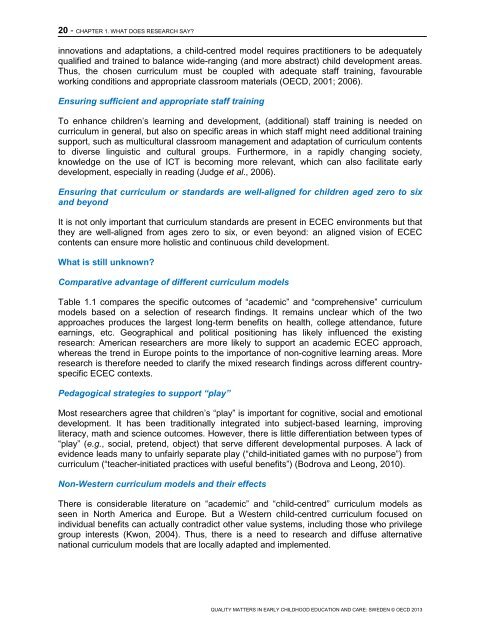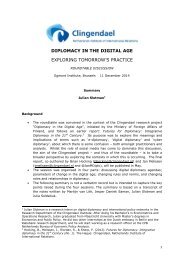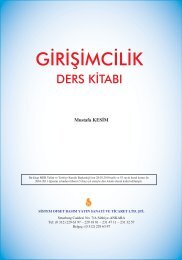SWEDEN%20policy%20profile%20-%20published%2005-02-2013
SWEDEN%20policy%20profile%20-%20published%2005-02-2013
SWEDEN%20policy%20profile%20-%20published%2005-02-2013
Create successful ePaper yourself
Turn your PDF publications into a flip-book with our unique Google optimized e-Paper software.
20 - CHAPTER 1. WHAT DOES RESEARCH SAY?<br />
innovations and adaptations, a child-centred model requires practitioners to be adequately<br />
qualified and trained to balance wide-ranging (and more abstract) child development areas.<br />
Thus, the chosen curriculum must be coupled with adequate staff training, favourable<br />
working conditions and appropriate classroom materials (OECD, 2001; 2006).<br />
Ensuring sufficient and appropriate staff training<br />
To enhance children’s learning and development, (additional) staff training is needed on<br />
curriculum in general, but also on specific areas in which staff might need additional training<br />
support, such as multicultural classroom management and adaptation of curriculum contents<br />
to diverse linguistic and cultural groups. Furthermore, in a rapidly changing society,<br />
knowledge on the use of ICT is becoming more relevant, which can also facilitate early<br />
development, especially in reading (Judge et al., 2006).<br />
Ensuring that curriculum or standards are well-aligned for children aged zero to six<br />
and beyond<br />
It is not only important that curriculum standards are present in ECEC environments but that<br />
they are well-aligned from ages zero to six, or even beyond: an aligned vision of ECEC<br />
contents can ensure more holistic and continuous child development.<br />
What is still unknown?<br />
Comparative advantage of different curriculum models<br />
Table 1.1 compares the specific outcomes of “academic” and “comprehensive” curriculum<br />
models based on a selection of research findings. It remains unclear which of the two<br />
approaches produces the largest long-term benefits on health, college attendance, future<br />
earnings, etc. Geographical and political positioning has likely influenced the existing<br />
research: American researchers are more likely to support an academic ECEC approach,<br />
whereas the trend in Europe points to the importance of non-cognitive learning areas. More<br />
research is therefore needed to clarify the mixed research findings across different countryspecific<br />
ECEC contexts.<br />
Pedagogical strategies to support “play”<br />
Most researchers agree that children’s “play” is important for cognitive, social and emotional<br />
development. It has been traditionally integrated into subject-based learning, improving<br />
literacy, math and science outcomes. However, there is little differentiation between types of<br />
“play” (e.g., social, pretend, object) that serve different developmental purposes. A lack of<br />
evidence leads many to unfairly separate play (“child-initiated games with no purpose”) from<br />
curriculum (“teacher-initiated practices with useful benefits”) (Bodrova and Leong, 2010).<br />
Non-Western curriculum models and their effects<br />
There is considerable literature on “academic” and “child-centred” curriculum models as<br />
seen in North America and Europe. But a Western child-centred curriculum focused on<br />
individual benefits can actually contradict other value systems, including those who privilege<br />
group interests (Kwon, 2004). Thus, there is a need to research and diffuse alternative<br />
national curriculum models that are locally adapted and implemented.<br />
QUALITY MATTERS IN EARLY CHILDHOOD EDUCATION AND CARE: SWEDEN © OECD <strong>2013</strong>








